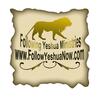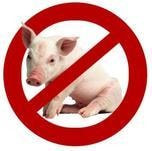(Leviticus 11, Deuteronomy 14 were used for list)
In Leviticus 11 and Deuteronomy 14 we find lists of clean and unclean animals. The first listing was given for the benefit of the generation that had escaped from Egyptian slavery. In Deuteronomy Yahweh reemphasized this instruction for the next generation as it was about to claim its new territory in the Promised Land.
The two chapters give the same reason for Yahweh’s instruction on clean and unclean meats. In Leviticus 11 Yahweh says that to “be holy” one must avoid the unclean. In Deuteronomy 14 Israel was told not to eat “any detestable thing” (Deuteronomy 14:3), “for you are a holy people to the LORD your Yahweh” (Deuteronomy 14:2-21). To be holy means to be set apart by Yahweh.
The specific purpose Yahweh gave for avoiding unclean meats is holiness. Yahweh wants us to be holy. Since we belong to Him and He purchased us with Yeshua’s blood, He does not want us to contaminate ourselves through any kind of physical or spiritual defilement (1 Corinthians 6:15-20). In Yahweh’s sight refraining from eating unclean animals is an identifying sign of the holiness of those Yahweh has set apart through a relationship with Him.
Those who honor Yahweh should reflect holiness in their thoughts and actions. Yahweh requires holy conduct, a way of life distinctly different from that of the rest of the world. Holiness in conduct is based in attitudes toward Yahweh, others and self that result in actions that avoid causing pain and build lasting beneficial relationships. Of course, being holy means much more than merely avoiding unclean meats. Yeshua spoke of the “weightier matters of the law,” such as judgment, mercy and faith (Matthew 23:23).
Yahweh gave His laws to physical people who suffer the consequences when they do not follow those laws. Breaking His law against adultery, for example, can destroy a marriage and family. Deuteronomy 28 records numerous calamities that befell the Israelites when they failed to obey the laws of Yahweh. But He said he would establish them as a holy people if they would keep His commandments (Deuteronomy 28:9).
Yahweh’s continuing desire for His people to be holy has remained constant. As Paul said, “He chose us in Him before the foundation of the world, that we should be holy and without blame before Him in love” (Ephesians 1:4).
Torah Clean Foods
FISH:
Must have both fins and scales
Albacore (Crevalle, Horse Mackerel)
Alewives (Branch & River Herring)
Anchovy
Barracuda
Blueback (Glut Herring)
Bass
Black Drum
Blackfish
Bluebill Sunfish
Bluefish
Blue Runner (Hardtail)
Bonitos
Boston Bluefish (Pollack)
Buffalofish
Butterfish
Bowfin
Carp
Chub (Bloate)
Longjaw, Blackfin)
Cod
Crappie
Crevalle (Albacore)
Croaker
Darter
Flounder (Dab, Gray Sole, Yellow Tail)
Frost Fish (Ice Fish, Smelt)
Gaby
Grayling
Groupers (Gag)
Grunts
Gulf Pike (Robalo, Snook, Sergeant)
Haddock
Hake
Halibut
Hardtail (Blue Runner)
Herring
Horse Mackerel (Albacore)
Kingfish
Long Nose Sucker
Northern Sucker,
Red Striped Sucker
Mackerel
Menhaden
Mullet
Muskellunge (Jack)
Orange Roughy
Perch
Pickerel (Jack)
Pig Fish
Pike (Jack)
Pilchard (Sardine)
Pollack
Pompano
Porgy (Scup)
Red Drum (Redfish)
Redfin (Red Horse Sucker)
Red Snapper
Red Striped Sucker
Robalo (Gulf Pike)
Rockfish
Salmon (Chum, Coho, King, Pink, Red)
Sardine (Pilchard)
Scup (Porgy)
Sea Bass
Sergeant Fish (Gulf Pike)
Shad
Sheepshead
Silver Hake (Whiting)
Silversides
Smelt (Frost Fish)
Snook (Gulf Pike)
Spanish Mackerel
Striped Bass
Sucker
Tarpon
Trout
Tuna (Albacore, Bluefin, Yellowfin)
Tuna (Shipjack)
Weakfish
Whitefish
White Sucker
Whiting (Silver Hake)
Yellow Perch
Torah Unclean Fish and Seafood:
Abalone
Bullhead
Catfish
Clam
Crab
Crayfish
Eel
Krill
Lobster
Moonfish
Mussel
Oyster
Paddlefish (Spoonbill)
Scallop
Sculpin
Shark
Shrimp
Squid
Stickleback
Sturgeon (Caviar)
Swordfish
Whale
RED MEAT:
Must chew the cud and have a divided hoof
Antelope
Beef
Buffalo
Deer
Elk
Giraffe (Not eaten due to being a protected species)
Goat
Moose
Sheep
Lamb
Torah Unclean Meats
Monkeys
Bears
Lions
Tigers
Leopards
Camels
Horses
Kangaroo/ Wallaby
Possums/Gophers/Squirrel
Donkey/Mule
Wombat/Beaver/Moles
Weasels/Ferrets/ Hares/ Rabbits
Mice/Rats
Rock Hyrax
Dogs
Cats
Pigs/Swine
FOWL:
Possess elongated middle toe and hind toe, crops and gizzards; not a raptor
Chicken
Dove
* Goose
Grouse
Pheasant
Pigeon
Quail
Turkey
ostrich
Torah Unclean Fowl
Eagles/ Hawk/ Vultures
Red & Black Kite
Owls
Ravens
Cormorant
Osprey
Stork
Falcon
Herons
Hoopoe
Bats
Sea Gulls
INSECTS:
every flying creeping thing that goeth upon all four, which have legs above their feet to leap upon the earth
Grasshoppers
Locusts
crickets
Torah Unclean Insects:
insects that don’t fly AND hop.
ALL CREEPING THINGS:
Caterpillars/ Worms
Snakes/ Eels
Lizards
Chameleon
Snails
Frogs/ Toads
Reptiles (alligator, crocodile, lizard, snake and turtle)
Marine Mammals (seal, walrus and sea lion)
Cetaceans (whale, porpoise and dolphin)
Misc. Marine Invertebrates (sea cucumber, star fish, jelly fish, sea anemone)
Also, all foods including breads and things that contain mono and diglycerides and also triglycerides. Be aware that products containing enzymes and stearic acid unless noted as vegetable stearic acid it all contains pig enzymes or other unclean animal by products.
Hidden Animal Ingredients
| Ingredient | What It Is | Its Use |
| Albumin | The protein component of egg whites. Albumin is also found in animal blood, milk, plants, and seeds. | To thicken or add texture to processed foods. |
| Anchovies | Small, silvery fish of herring family. | Worcestershire sauce, Caesar salad dressing, pizza topping, Greek salads. |
| Animal shortening | Butter, suet, lard (see lard below). | Packaged cookies and crackers, refried beans, flour tortillas, ready-made pie crusts. |
| Carmine (carmine, cochineal, or carminic acid) | Red coloring made from a ground-up insect. | Bottled juices, colored pasta, some candies, frozen pops, “natural” cosmetics. |
| Calcium stearate | Mineral typically derived from cows or hogs | Garlic salt, vanilla, meat tenderizers, salad-dressing mixes. |
| Capric acid (decanoic acid) | Animal fats | added to ice cream, candy, baked goods, chewing gum, liquor and often not specified on ingredients lists. |
| Casein (caseinate) | A milk protein. It coagulates with the addition of rennin (see rennin below) and is the foundation of cheese. | An additive in dairy products such as cheese, cream cheese, cottage cheese, and sour cream. Also used in adhesives, paints, and plastics. |
| Clarifying agent | Derived from any number of animal sources. | Used to filter wine, vinegar, beer, fruit juice, soft drinks. |
| Gelatin | Protein from bones, cartilage, tendons, and skin of animals, Much of the commercial gelatin is a by-product of pig skin. | Marshmallows, yogurt, frosted cereals, gelatin-containing desserts, molded salads.. |
| Glucose (dextrose) | Fruits or animal tissues and fluids. | Baked goods, soft drinks, candies, frosting. |
| Glycerides (mono-, di-, and triglycerides | Glycerol from animal fats or plants. | Processed foods, cosmetics, perfumes, lotions, inks, glues, automobile antifreeze. Used as emulsifier. |
| Isinglass | Gelatin from air bladder of sturgeon and other freshwater fish. | Clarify alcoholic beverages and in some jellied desserts. Rarely used now. |
| Lactic acid | Acid formed by bacteria acting on the milk sugar lactose. Imparts a tart flavor. | Cheese, yogurt, pickles, olives, sauerkraut, candy, frozen desserts, chewing gum, fruit preserves, dyeing and textile printing. |
| Lactose (saccharum lactin, D-lactose | Milk sugar. | Culture medium for souring milk and in processed foods such as baby formulas, candies and other sweets, medicinal diuretics, and laxatives. |
| Lactylic stearate | Salt of stearic acid (see stearic acid below). | Dough conditioner. |
| Lanolin | Waxy fat from sheep’s wool. | Chewing gum, ointments, cosmetics, waterproof coatings. |
| Lard | Rendered and clarified pork fat. Often fat from abdomens of pigs or the fat around the animal’s kidneys. | Baked goods. |
| Lecithin | Phospholipids form animal tissues, plants, lentils, and egg yolks used to preserve, emulsify, and moisturize food. | Cereal, candy, chocolate, baked goods, margarine, vegetable oil sprays, cosmetics, and ink. |
| Lutein | Deep yellow coloring from marigolds or egg yolks. | Commercial food coloring. |
| Myristic acid (tetradecanoic acid) | Animal fats. | Chocolate, ice cream, candy, jelled desserts, baked goods. |
| Natural flavorings | Unspecified, could be from meat or other animal products | Processed and packaged foods. |
| Oleic acid (oleinic acid) | Animal tallow (see tallow below) | Synthetic butter, cheese, vegetable fats and oils, spice flavoring for baked goods, candy, ice cream, beverages, condiments, soaps, cosmetics. |
| Palmatic acid | Animal or vegetable fats. | Baked goods, butter and cheese flavoring. |
| Pancreatin (pancreatic extract) | Cows or hogs | Digestive aids. |
| Pepsin | Enzyme from pigs’ stomachs | With rennet to make cheese. |
| Propolis | Resinous cement collected by bees | Food supplement and ingredient in “natural” toothpaste. |
| Rennin (Rennet) | A coagulating enzyme obtained from a young animal’s stomach, usually a calf’s stomach | Rennin is used to curdle milk in foods such as cheese and junket–a soft pudding like dessert. |
| Royal jelly | Substance produced by glands of bees. | “Natural foods” and nutrient supplements. |
| Sodium stearoyl lactylate | May be derived from cows, hogs, animal milk, or vegetable-mineral sources. | Used in cake, pudding, or pancake mixes, baked goods, margarine. |
| Stearic acid (octadecenoic acid) | Tallow, other animal fats and oils | Vanilla flavoring, chewing gum, baked goods, beverages, candy, soaps, ointments, candles, cosmetics, suppositories and pill coatings. |
| Suet | Hard white fat around kidneys and loins of animals | Margarine, mincemeat, pastries, bird feed, tallow. |
| Tallow | Solid fat of sheep and cattle separated from the membranous tissues | Waxed paper, margarine, soaps, crayons, candles, rubber, cosmetics. |
| Vitamin A (A1, retinol) | Vitamin obtained from vegetables, egg yolks, or fish liver oil. | Vitamin supplements, fortification of foods, “natural” cosmetics. |
| Vitamin B12 | Vitamin produced by microorganisms and found in all animal products; synthetic form (cyanocobalamin or cobalamin on labels) is vegan | Supplements or fortified foods. |
| Vitamin D (D1, D2, D3) | D1 is produced by humans upon exposure to sunlight; D2 (ergocalciferol) is made from plants or yeast, D3 (cholecalciferol comes from fish liver oils or lanolin | Supplements or fortified foods. |
| Whey | Watery liquid that separates from the solids (curds) of milks in cheese-making. | Crackers, breads, cakes, processed foods in cheese-making. |


